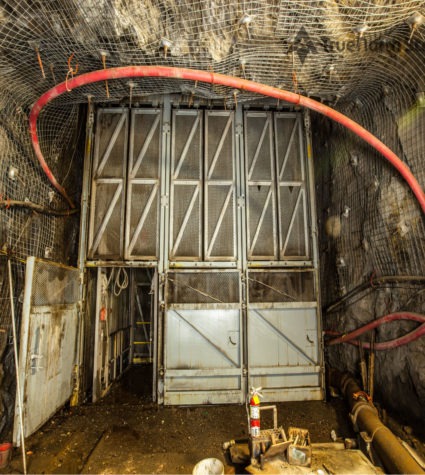FEATURED PROJECT: The Ross Shaft at the Sanford Underground Research Facility
Neutrinos are the most abundant matter particles in the universe. These tiny particles are produced in large quantities in the sun and stars and smaller quantities inside the earth. Now, scientists are exploring whether neutrinos could be why the universe is produced of matter. To do that, scientists are using particle accelerators to create and analyze both neutrinos and anti-neutrinos.
The experiment is a collaboration between the U.S. Department of Energy’s Fermilab and the Sanford Underground Research Facility (SURF). Using powerful particle accelerators, scientists at the Fermilab facility in Illinois will produce and shoot neutrinos towards SURF’s Long-Baseline Neutrino Facility (LBNF) in South Dakota. In just 4 milliseconds, the neutrinos will travel 1,300 kilometers through the earth and be caught by detectors located 1.5 kilometers underground. The information collected during the experiment will provide scientists with a greater insight into the universe and how it works.
The Impact of DUNE/LBNF
In addition to solving some of the universe’s greatest mysteries, this project will also have a significant impact on the economy. Construction is expected to produce an estimated 2,000 jobs in both South Dakota and Illinois over the next 10 years. Once the facility is completed and the project is underway, the experiment is set to last 20 years. During that time, the collaboration between SURF and Fermilab will:
- Employ the best and brightest from around the globe
- Generate an estimated 1 billion dollars in SD and 1.2 billion in IL
- Create a demand for jobs, products, and services
- Produce high-tech innovations and technology
The SURF Ross Shaft is a Key Component to the Experiment
Before the experiment can be conducted, the SURF Ross Shaft must be refurbished and expanded. Originally built in 1932, the Ross Shaft is part of the former Homestake Gold Mine. When it became part of Sanford’s underground research lab in 2008, it was clear the structure required updating to accommodate the needs of science. In addition to refurbishing the structure, the shaft will be expanded to 5,000 feet and will house the particle detectors essential to the experiment.
In 2012, crews began the process of removing the old steel and lacing and began replacing it with new steel and ground supports. Since refurbishing the Ross Shaft began, TrueNorth Steel has delivered 3,050 tons of steel to the Sanford Underground Research Facility. These steel products include structural steel and brattice panels, as well as other products needed to support the specialized structural design of the project.
Interested in learning more about SURF and the innovative experiments performed there? The Sanford Lab Homestake Visitor center in Lead, SD offers a surface tour of Sanford Underground Research Facility. The tour includes detailed information about the history of the mines and provides samples of TrueNorth Steel products used throughout. You can also learn more about TrueNorth Steel’s contribution to the Ross Shaft project here or by contacting our team.

